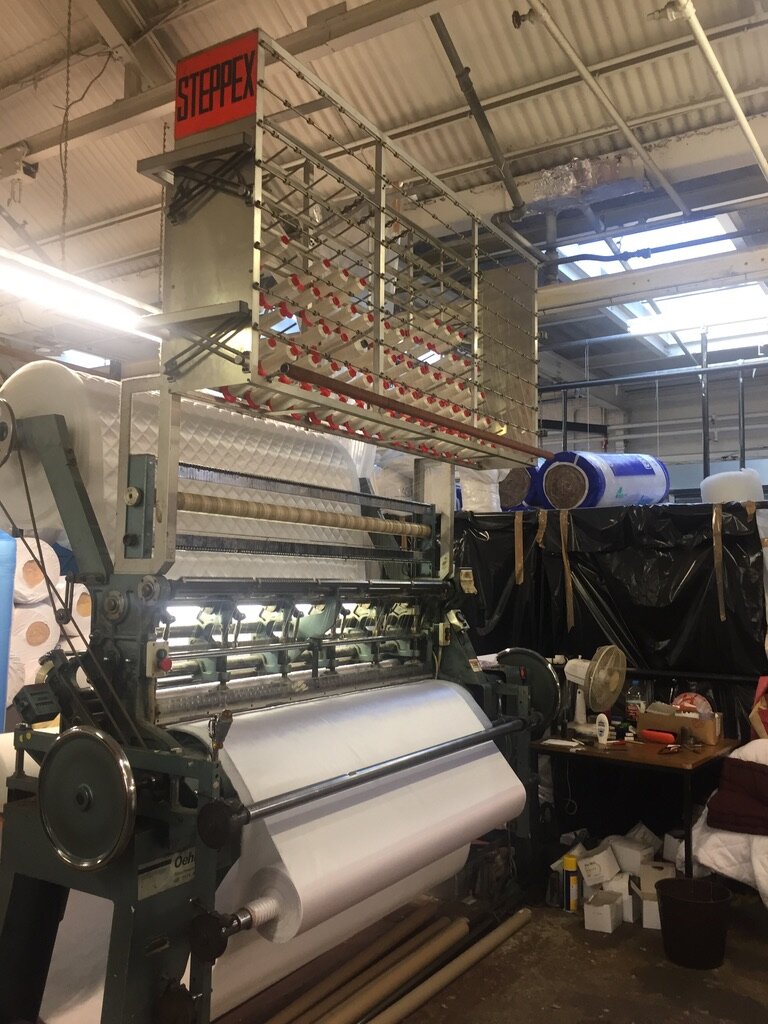Katie Schwab
Still Here
During her residency at The White House, Katie Schwab has been exploring overlooked histories of industrial, domestic and material culture in Dagenham.
With a particular interest in offcuts, handicrafts and creative learning, Katie has been meeting with local residents, organisations and manufacturers to explore workwear designs, items made from by-products of industry and the costume designs of former White House resident, Hardy Amies*.
Drawing on these conversations and research, Katie is now developing a new collection of functional textiles inspired by materials that have been cut out or ‘leftover’.
The collection is being developed in collaboration with local manufacturers and makers, and will be used at The White House and in other domestic spaces, creating material connections between homes across Becontree.
Still Here takes its name from the autobiography of fashion designer, Hardy Amies, which charts his lifetime’s journey with fabric, and shapes the framework through which this project has evolved.
Abbey Quilting, Dagenham
Abbey Quilting, Dagenham
Dagenham has long been synonymous with manufacturing, known for companies such as Ford Dagenham (employing 40,000 workers in its 1950’s heyday), May & Baker and Sterling, many of which have since closed or downsized. Still Here seeks to explore methods of weaving, stitching and quilting; platforming local manufacturers and traditions of making that are still here.
Stitching workshop session at The White House, 2020
Quilt made at Abby Quilting, Dagenham
Stitching workshop session at The White House, 2020
The Folders: Archive of Ford workers' struggles at Dagenham 1971-89
Document from Ed Emery’s archive
In spring 2019 Katie Schwab and her father Ed Emery began a period of research at The White House, marking the first collaboration between artist, Katie Schwab and her father Ed Emery, a writer, political activist and researcher who has been documenting labour struggles in the motor industry since the early 1970s.
Starting with Ed Emery’s archive of Ford activism in the 1970s, exploring its gaps in relation to gender and the home, Katie’s research expanded into a study of the costumes designed by Hardy Amies, former White House resident and fashion designer, for Stanley Kubrick’s 2001: A Space Odyssey.
In this film, many scenes of women and children in Amies’ costumes have been cut from the final version. Looking at these absences of representation both within the film and archives, Katie has been looking at ways to revisit, and make visible, local forms of domestic and industrial labour.
Document from Ed Emery’s archive
Fordite a.k.a. Dagenham Agate, Valence House Museum archive, London Borough of Barking and Dagenham. Fordite is produced as a by-product of the car spraying process at the Dagenham Ford Factory during the 1970s.
Katie’s projects evolve through explorations of personal, social, and craft-based histories, developing through embedded research and workshops in arts, learning and community contexts.
*Hardy Amies spent his childhood in Dagenham, living in The White House, while his father was overseeing the building of the Becontree Estate. Amies went onto to become a world famous fashion designer, best known for his official title as dressmaker for Queen Elizabeth II.
A Working Building, The Gallery at Plymouth College of Art, Plymouth, 2019
About Katie Schwab
Katie Schwab’s practice interweaves personal, social, and craft-based histories, often drawing from overlooked traditions of living, making and working collectively. Spanning exhibition-making, design commissions, printed resources and workshops, she works across arts, learning and community contexts to explore histories of domestic, social and civic design.
Recent exhibitions include A Working Building, The Gallery at Plymouth College of Art, Plymouth (2019); Jerwood Solo Presentations, Jerwood Space, London (2016); Making the Bed, Laying the Table, Glasgow Sculpture Studios, Glasgow (2016) and Together in a Room, Collective, Edinburgh (2016). Recent projects include This Interesting and Wonderful Factory, Clore Sky Studio Commission, Tate St Ives, St Ives (2018); Atrium Commissions, mima, Middlesbrough (2017) and A Portable Mural, Serpentine Galleries, London (2017). She was the recipient of the 2016 Nigel Greenwood Art Prize, the 2017 Wilhelmina Barns-Graham Residency at Porthmeor Studios, St Ives, the 2018/19 New Contemporaries/ SPACE Studio Bursary and the 2017-19 Design Residency at Plymouth College of Art.
About Ed Emery
Ed Emery’s archive of material relates to the strikes and factory-interventions at Ford in 1975-1985, including sound recordings, leaflets, photographs, magazines and official Ford Company and trade union documentation. In June 1978, Red Notes* published The Little Red Blue Book authored by Ed Emery. The pamphlet contains reports, diary entries, photographs and drawings detailing layoffs and labour disputes at the Dagenham Ford Factory. A nod to Ford’s The Blue Book (a handbook of agreements between Ford and the trade unions) and China’s Little Red Book, the pamphlet was a manual attempting to map out a revolutionary practice which could operate in the day to day realities of struggle inside the Ford factories.












